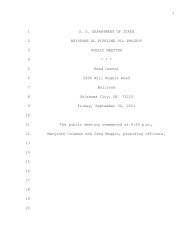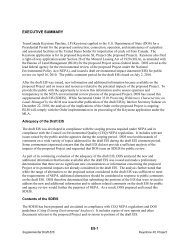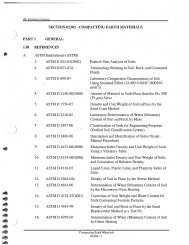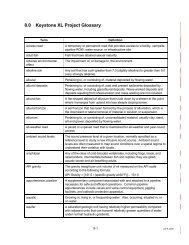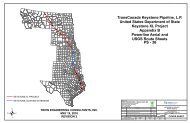2.1 Overview of the Proposed Project - Keystone XL pipeline - US ...
2.1 Overview of the Proposed Project - Keystone XL pipeline - US ...
2.1 Overview of the Proposed Project - Keystone XL pipeline - US ...
You also want an ePaper? Increase the reach of your titles
YUMPU automatically turns print PDFs into web optimized ePapers that Google loves.
Draft Supplemental Environmental Impact Statement<strong>Keystone</strong> <strong>XL</strong> <strong>Project</strong>environments are difficult to contain primarily because bentonite readily disperses in flowingwater and quickly settles in standing water. Fur<strong>the</strong>r discussion <strong>of</strong> frac-outs is presented inSection 4.3, Water Resources; Section 4.7, Fisheries; and Section 4.8, Threatened andEndangered Species and Species <strong>of</strong> Conservation Concern.<strong>2.1</strong>.9.2 Wetland CrossingsConstruction across wetlands would be similar to typical conventional upland cross-countryconstruction, with modifications to reduce <strong>the</strong> potential for effects to wetland hydrology and soilstructure. The wetland crossing methods used would depend largely on <strong>the</strong> stability <strong>of</strong> <strong>the</strong> soils at<strong>the</strong> crossing location at <strong>the</strong> time <strong>of</strong> construction. The 110-foot <strong>pipeline</strong> construction corridorwidth would be reduced to 85 feet for wetlands in Montana and Nebraska, and 75 feet forwetlands in South Dakota, unless conditions require a wider construction corridor. In instanceswhere <strong>the</strong> wetland is supersaturated or inundated, <strong>the</strong> corridor ROW may be increased to ensuresafe construction conditions. The operation ROW would be 30 feet in all three states, unlessconditions require a wider permanent ROW width.If wetland soils are not excessively saturated at <strong>the</strong> time <strong>of</strong> construction and can supportconstruction equipment without equipment mats, construction would occur in a manner similarto conventional upland cross-country construction techniques. Low ground pressure equipmentor conventional equipment supported by pre-fabricated matting would be used in all wetlands.Where wetlands are located at <strong>the</strong> base <strong>of</strong> slopes, permanent slope breakers would be constructedacross <strong>the</strong> ROW in upland areas adjacent to <strong>the</strong> wetland boundary. Temporary sediment barrierswould be installed where necessary until revegetation <strong>of</strong> adjacent upland areas is successful.Additional TWAs would be required on both sides <strong>of</strong> saturated or inundated wetlands to stageconstruction, fabricate <strong>the</strong> <strong>pipeline</strong>, and store materials. These additional TWAs would belocated in upland areas a minimum <strong>of</strong> 10 feet from <strong>the</strong> wetland edge. More information islocated in <strong>the</strong> Site-Specific Waterbody Crossing Plans located in <strong>the</strong> CMRP (Appendix G) withrecommended modifications to <strong>the</strong> CMRP provided in Section 4.4.4, Recommended AdditionalMitigation.Clearing <strong>of</strong> vegetation in wetlands within <strong>the</strong> construction corridor would be limited to trees andshrubs, which would be cut flush with <strong>the</strong> surface <strong>of</strong> <strong>the</strong> ground, leaving <strong>the</strong> root stock in place,and removed from <strong>the</strong> wetland. Scrub-shrub and forested communities would be allowed toregenerate outside <strong>of</strong> <strong>the</strong> maintained operations ROW, and in areas where HDD was used to spanopen water areas. To avoid excessive disruption <strong>of</strong> wetland soils and <strong>the</strong> native seed androotstock within <strong>the</strong> wetland soils, stump removal, grading, topsoil segregation, and excavationwould be limited to <strong>the</strong> area immediately over <strong>the</strong> trench line to <strong>the</strong> maximum extent practicable.Trench breakers would be installed where necessary to prevent <strong>the</strong> subsurface drainage <strong>of</strong> waterfrom wetlands. Trench width may vary in some wetlands to provide an even, safe work area,which depends upon topography, soil moisture content, and groundwater levels. Severetopography may require additional disturbance to create an even safe work area. More saturatedsoils usually require a wider trench in order to maintain a safe ditch and to avoid unstable trenchwalls. During clearing, sediment barriers, such as silt fence and staked straw bales, would beinstalled and maintained on down slopes adjacent to all wetlands and within additional TWAs, asnecessary, to minimize <strong>the</strong> potential for sediment run<strong>of</strong>f.Construction equipment working in all wetlands would be limited to <strong>the</strong> area essential forclearing <strong>the</strong> ROW, excavating <strong>the</strong> trench, fabricating and installing <strong>the</strong> <strong>pipeline</strong>, backfilling <strong>the</strong><strong>Project</strong> Description <strong>2.1</strong>-60 March 2013



